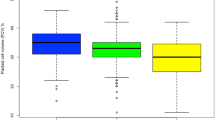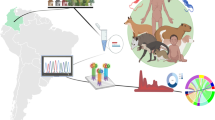Abstract
The application of nucleic acid hybridization techniques in the identification of most protozoan parasites, using species-specific DNA probes, has recently been described by several investigators. Species-specific DNA probes have been employed in the characterization of trypanosome infections in cattle and tsetse from Uganda. Most infections revealed by our DNA probes were mixed. Using these probes, a mixed infection with Trypanosoma brucei, T. vivax and both savannah and Kilifi types of T. congolense was revealed in one cow. This mixed infection could not have been detected by any of the classical parasitological methods. Isolates made from natural field infections, which had been passaged in laboratory animals, were found to consist of homogeneous trypanosome species. This was demonstrated in all of 47 stabilates which were homogeneous infections either of savannah type T. congolense or T. brucei.
The method of sample preparation for DNA probe analysis was modified to suit field conditions. The samples, which were spot-blotted onto nylon niters and either immediately denatured or left undenatured, could be kept at room temperature for 1 month with only a moderate loss of hybridization signal intensities. Although hybridization signals were visible in undenatured samples, those seen with the samples that had been denatured were clearly more intense. This approach eliminates the need for liquid nitrogen and/or an incubator in the field. The simplicity, sensitivity and specificity of this diagnostic technique using species-specific DNA probes, make it an important tool for future studies of the epidemiology of African trypanosomiases.
Résumé
L’emploi de techniques d’hybridation des acides nucléiques pour identifier la plupart des parasites protozoaires a été récemment décrit par plusieurs groupes. Des sondes ADN spécifiques de l’espèce ont été utilisées pour caractériser des infections dues aux trypanosomes chez les bovins et les mouches tsé-tsé en provenance de l’Ouganda. La plupart des infections étaient mixtes: par exemple, chez une vâche, une infection mixte par Trypanosome brucei, T. vivax ainsi que par T. congolense du type Kilifi et des savannes. Cette infection mixte n’aurait pas pu être détectée par les méthodes classiques de parasitologic. 47 isolats obtenus d’infections dans la nature et passés dans des animaux de laboratoire ont tous contenu des espèce homogénes, de type savanne T. brucei ou T. congolense.
La préparation d’échantillons était modifiée pour tenir compte des conditions sur le terrain. Les échantillons, spottés sur des filtres nylon en double, dont un soumis à dénaturation, pouvaient être maintenus à temperature ambiente pendant 1 mois avec seulement une perte modérée d’intensité du signal. Les signaux obtenus avec les échantillons dénaturés étaient plus intense que ceux obtenus avec les échantillons non-dénaturés. Cette approche supprime le besoin de recourir à l’azote liquide et/ou d’un incubateur sur le terrain. La simplicité, la sensibilité et la spécificité de cette technique diagnostique basée sur l’utilisation de sondes ADN spécifiques de l’espèce en font un outil important pour les futures études d’épidemiologie de la trypanosomiase africaine.
Similar content being viewed by others
References
Allsopp B., Carrington M., Baylis H., Sohal S., Dolan T. and Iams K. (1989) Improved characterization of Theileria parva isolates using the polymerase chain reaction and oligonucleotide probes. Mol. Biochem. Parasitol. 35, 137–148.
Ashcroft M. T. (1959) The importance of African wild animals as reservois of trypanosomiasis. E. Afr. Med. J. 36, 289–297.
Barnes B. A., Mottram J., Selkirk M. and Agabian N. (1989) Two variant surface glycoprotein genes distinguish between substrains of Trypanosoma brucei gambiense. Mol. Biochem. Parasitol. 34, 135–146.
Borst P., Fase-Fowler F., Frasch A. C. C., Hoeijmakers J. H. J. and Weijers P. J. (1980) Characterization of DNA from Trypanosoma brucei and related trypanosomes by restriction endonuclease digestion. Mol. Biochem. Parasitol. 1, 221–246.
Buxton P. A. (1955) The Natural History of Tsetse Flies. London School of Hygiene and Tropical Medicine Mem. No. 10, London.
Dickin S. K. and Gibson W. C. (1989) Hybridization with a repetitive probe reveals the presence of small chromosomes in Trypanosoma vivax. Mol. Biochem. Parasitol. 33, 135–142.
Feinberg A. P. and Vogelstein B. (1983) A technique for radio-labelling DNA restriction endonuclease fragments to high specific activity. Anal. Biochem. 132, 6–13.
Engvall E. and Perlman P. (1971) Enzyme-linked immunosorbent assay (ELISA). Quantitative assay of immunoglobulin G. Immunochem. 8, 871–879.
Gashumba J. K. (1986) Two enzymatically distinct stocks of 7. congolense. Res. Vet. Sci. 40, 411–412.
Gibson W. G., Dukes P. and Gashumba J. K. (1988) Species-specific DNA probes for the identification of African trypanosomes in tsetse flies. Parasitol. 97, 63–73.
Godfrey D. G., Killick-Kendrick R. and Ferguson W. (1965) Bovine trypanosomiasis in Nigeria. IV. Observations on cattle trekked along a trade-cattle route through areas infested with tsetse fly. Ann. Trop. Med. Parasitol 59, 255–269.
Hoare C. A. (1972) The Trypanosomes of Mammals. A Zoological Monograph. Blackwell Scientific Publications (London) pp. 1–749.
Kimmel B. E., ole-MoiYoi O. K. and Young J. R. (1987) Ingi, a 5.2 kb dispersed sequence element from Trypanosoma brucei that carries half of a smaller mobile element at either end and has homology with mammalian lines. Mol. Cell. Biol. 7, 1465–1475.
Knowles G., Betschart B., Kukla B. A., Scott J. R. and Majiwa P. A. O. (1988) Genetically discrete populations of Trypanosoma congolense from livestock on the Kenya Coast. Parasitol 96, 461–474.
Kukla B. A., MajiwaP. A. O., Young J. R., Moloo S. K. and ole-MoiYoi O. K. (1987) Use of species-specific DNA probes for detection and identification of trypanosome infection in tsetse flies. Parasitol. 95, 1–16.
Kurstak E. (1986) Enzyme Immunodiagnosis. Academic Press (London, New York).
Losos G. J. and Ikede B. O. (1972) Review of pathology of diseases in domestic and laboratory animals caused by Trypanosoma congolense, T. vivax, T. brucei, T. rhodesiense and T. gambiense. Vet. Pathol. (suppl.) 9, 1–71.
Lumsden W.H.R., Herbert W.H. and McNeillage G. J. C. (1973) Techniques with Trypanosomes. Churchill Livingston Publishers, Edinburgh and London, pp. 57–94.
Majiwa P. A. O., Hamers R., Van Meirvenne N. and Matthyssens G. (1986) Evidence for genetic diversity in Trypanosoma (Nannomonas) congolense. Parasitol 93, 291–304.
Majiwa P. A. O., Masake R. A., Nantulya V. M., Hamers R. and Matthyssens G. (1985) Trypanosoma (Nannomonas) congolense Identification of two karyotypic groups. EMBO J. 4, 3307–3313.
Majiwa P. A. O. and Otieno L. H. (1989) Species-specific DNA probes reveal simultaneous infection of tsetse flies with different trypanosome species. In VIII International Congress of Protozoology, Japan, 1989. Abstract No. HD 1545.
Maniatis T., Fritsch E. F. and Sambrook J. (1982) Molecular Cloning: A Laboratory Manual. New York, Cold Spring Harbor Laboratory.
Masake R. A., Nyambati V. M., Nantulya V. M., Majiwa P. A. O., Moloo S. K. and Musoke A. J. (1988) The chromosome profiles of Trypanosoma congolense isolates from Kilifi, Kenya, and the relationship to serodeme identity. Mol. Biochem. Parasitol 30, 105–112.
Massamba N. N. and Williams R. O. (1984) Distinction of African trypanosome species using nucleic acid hybridization. Parasitol. 88, 55–65.
McNamara J., Snow W.F. and Gibson W.C. (1989) DNA probes for identification of trypanosomes in tsetse flies. International Council for Trypanosomiasis Research and Control (ISCTRC) Proceedings 20th Meeting Mombasa, Kenya 1989. Abstract No. 305.
Meinkoth J. and Wahl G. (1984) Hybridization of nucleic acids immobilized on solid supports. Anal. Biochem. 138, 267–284.
Moloo S. K., Dar F. and Kamunya G. W. (1982) The transmission of mixed infections of pathogenic Trypanosoma species to susceptible hosts by Glossina morsitans. Acta Trop. 39, 303–306.
Mullis K. B. and Faloon F. A. (1987) Specific synthesis of DNA in vitro via a polymerase catalysed chain reaction. Methods in Enzymol. 155, 335–350.
Mulligan H. W. (1970) The African Trypanosomiases. George Allen and Unwin, London, pp. 1–950.
Nantulya V. M. (1989) An antigen detection enzyme immunoassay for diagnosis of rhodesiense sleeping sickness. Parasite Immunol. 11, 69–75.
Nantulya V. M., Lindquist K. J., Diall O. and Olaho-Mukani W. (1989) Two simple antigen-detection enzyme immunoassays for the diagnosis of Trypanosoma evansi infections in the dromedary camel (Camelus dromedarius). Trop. Med. Parasitol 40, 415–418.
Nyeko J. H. P., MajiwaP. A. O. and ole-MoiYoi O. K. (1989) Field application of recombinant DNA probes in the identification of trypanosome isolates from Uganda. In VIII International Congress of Protozoology, Japan, 1989. Abstract No. 11D 1530.
ole-MoiYoi O. K. (1987) Trypanosome species-specific DNA probes to detect infection in tsetse flies. Parasitol Today 3, 71–74.
Oste C. (1988) Polymerase chain reaction. BioTech. 6, 162–167.
Paindavoine P., Pays E., Laurent M., Geltmeyer Y., LeRay D., Mehlitz D. and Steinert M.(1986)The use of DNA hybridization and numerical taxonomy in determining relationships between Trypanosoma brucei stocks and subspecies. Parasitol. 92, 31–50.
Paris J., Murray M. and McOdimba F. A. (1982) A comparative evaluation of the parasitological techniques currently available for diagnosis of African trypanosomiasis in cattle. Acta Trop. 39, 307–316.
Pettersson U. and Hyppia T. (1985) Nucleic Acid Hybridization; an alternative tool in diagnostic microbiology. Immunol. Today 6, 268–272.
Rickman L. R. and Robson J. (1970) The testing of proven Trypanosoma brucei and T. rhodesiense strains by blood incubation infectivity test. Bull WHO 42, 911–916.
Tijssen P. (1985) Practice and theory of enzyme immunoassays. In Laboratory Techniques in Biochemistry and Molecular Biology (Edited by Burdon and Knippenberg), pp. 1–349. Elsevier, New York.
Viscindi R. P. and Yolken R. H. (1987) Molecular diagnosis of infectious diseases by nucleic acid hybridization. Mol. and Cell. Probes 1, 3–14.
Yolken R. H. (1982) Enzyme immunoassays for the detection of infectious antigens in body fluids: Current limitations and future prospects. Rev. Infect. Dis. 4, 35–67.
Young C. J. and Godfrey D. G. (1983) Enzyme polymorphism and the distribution of Trypanosoma congolense isolates. Ann. Trop. Med. Parasitol 77, 467–481.
Wirth D. F. and McMahon-Platt D. (1982) Rapid identification of Leishmania species by specific hybridization of kinetoplast DNA in cutaneous lesions. Proc. Nat. Acad. Sci. (USA) 79, 6999–7003.
Author information
Authors and Affiliations
Rights and permissions
About this article
Cite this article
Nyeko, J.H.P., Ole-Moiyoi, O.K., Majiwa, P.A.O. et al. Characterization of Trypanosome Isolates from Cattle in Uganda using Species-Specific DNA Probes Reveals Predominance of Mixed Infections. Int J Trop Insect Sci 11, 271–280 (1990). https://doi.org/10.1017/S1742758400012674
Received:
Published:
Issue Date:
DOI: https://doi.org/10.1017/S1742758400012674




